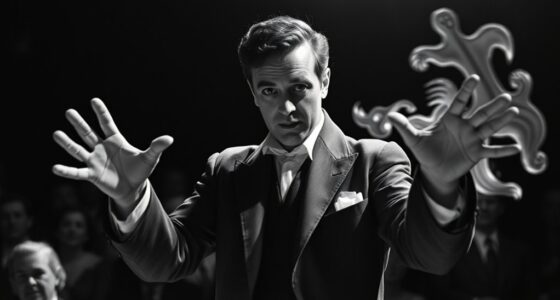The legend of Dracula blends truth and fiction, rooted in the life of Vlad the Impaler, a 15th-century ruler known for his brutal defense against the Ottomans. Bram Stoker’s 1897 novel transformed him into a suave vampire, intertwining history with myth. This fictional Count, inspired by Vlad’s fearsome reputation, distorts the reality of his legacy. As you explore further, you’ll uncover how these narratives shaped perceptions and cultural identities in Romania and beyond.
Key Takeaways
- Vlad III, known as Vlad the Impaler, inspired the Dracula legend, blending his historical brutality with fictional elements in Bram Stoker’s novel.
- Stoker’s *Dracula* introduced supernatural traits, but the character’s roots lie in the complex legacy of Vlad III.
- Misinterpretations of Vlad’s legacy as a cruel figure overshadow his role as a national hero defending against Ottoman invasions.
- Global vampire fascination, sparked by Stoker, distorts historical facts and alters perceptions of Eastern European culture.
- Transylvania’s rich folklore and historical sites, like Bran Castle, enhance the Dracula narrative while providing insights into Romanian culture and history.
The Historical Vlad III: The Man Behind the Myth
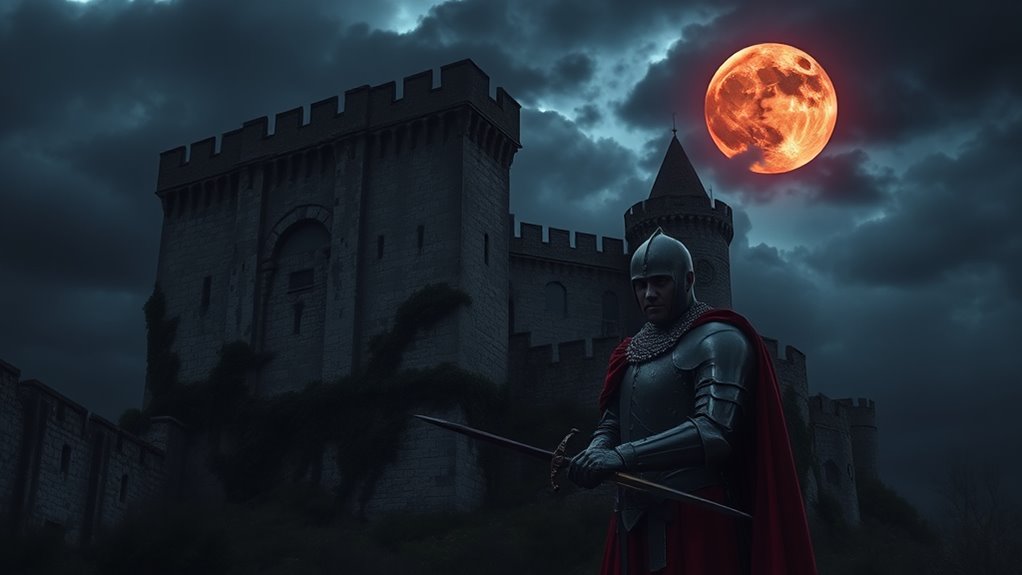
When you explore the legend of Dracula, it’s essential to understand the man behind the myth: Vlad III, also known as Vlad the Impaler. Born in 1431, he ruled Wallachia with an iron fist, notorious for his brutal methods, particularly impalement.
Despite his fearsome reputation, many Romanians view him as a national hero, defending against Ottoman invasions and enforcing strict laws that reduced crime. His father, Vlad II Dracul, was a member of the Order of the Dragon, which shaped Vlad’s identity.
Many Romanians regard Vlad the Impaler as a national hero for his defense against the Ottomans and strict law enforcement.
German propaganda exaggerated his cruelty, blending fact with fiction. This twisted narrative laid the groundwork for Bram Stoker’s iconic vampire.
Understanding Vlad the Impaler helps you appreciate the complex history that inspired the legend of Dracula.
Bram Stoker’s Creation: Crafting the Iconic Vampire

The transformation of Vlad the Impaler into the legendary Count Dracula marks a significant shift in how folklore and history intertwine.
Bram Stoker’s *Dracula*, published in 1897, introduces you to a centuries-old vampire nobleman whose charm and complexity redefine traditional vampire lore.
With its unique epistolary format, you experience Dracula’s sinister actions through multiple narrators, heightening the suspense.
Stoker crafts Dracula as a powerful figure capable of shapeshifting, commanding animals, and manipulating weather, blending gothic horror with supernatural abilities.
Drawing inspiration from Vlad III, Stoker connects the fictional vampire to real narratives of brutality and heroism in Romania.
His extensive research into Romanian history and folklore shapes Dracula’s character, cementing its lasting impact on popular culture.
The Blending of Fact and Fiction in Dracula’s Narrative

Although Bram Stoker’s *Dracula* is steeped in gothic horror and supernatural elements, it intricately weaves real historical threads with fiction to create a compelling narrative.
The character of Count Dracula draws inspiration from Vlad III, known as Vlad the Impaler, blending his brutal reputation with a sophisticated persona. Stoker’s research into Romanian history and folklore helps shape a Dracula who embodies nobility, though this contrasts sharply with Vlad’s harsh tactics against enemies.
The name “Dracula,” linked to Vlad II’s ties to the Order of the Dragon, suggests themes of heroism. Misinterpretations arise when you consider the modern Romanian word “drac,” meaning “devil,” contributing to the portrayal of Dracula as a monstrous figure rather than a complex historical character.
Misinterpretations and Cultural Impact of the Legend
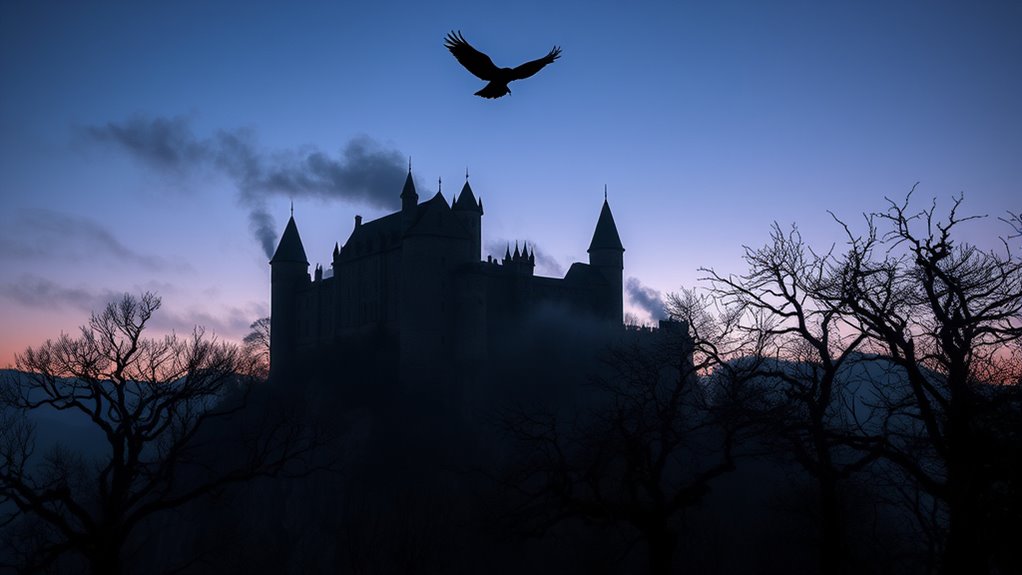
When you explore the legend of Dracula, you’ll quickly notice the stark differences between Bram Stoker’s fictional Count and the historical Vlad III.
This misrepresentation has fueled a global fascination with vampire lore, shaping how we view both Dracula and the culture surrounding him.
As a result, the legend not only distorts history but also enhances tourism in Romania, making it a compelling topic for discussion.
Historical vs. Fictional Dracula
Count Dracula, a name synonymous with horror, blurs the lines between history and fiction, creating a fascinating tapestry of misinterpretation. While Bram Stoker’s Dracula embodies a charming yet monstrous vampire, the historical figure Vlad III, known as Vlad the Impaler, was a complex ruler celebrated for defending Wallachia against the Ottomans. Misconceptions arise as “Dracul” translates to “devil” in modern Romanian, overshadowing Vlad’s true legacy. The novel’s success fueled vampire myths across Europe, altering perceptions of Eastern European culture. Here’s a quick comparison:
| Historical Figure | Fictional Dracula |
|---|---|
| Vlad III | Created by Bram Stoker |
| Hero in Romania | Blood-sucking vampire |
| Complex ruler | Charismatic monster |
| Defender of Wallachia | Embodiment of folklore |
Global Vampire Fascination
The global fascination with vampires has evolved markedly since Bram Stoker introduced Count Dracula to the world. This obsession often misrepresents the real Dracula, Vlad III, who was a complex figure celebrated in Eastern European history for his resistance against the Ottoman Empire.
Stoker’s portrayal helped shape a monstrous image that overshadowed Vlad’s role as a national hero in Romania. The 17th and 18th centuries’ vampire hysteria fueled public imagination, leading to countless adaptations in films, literature, and video games that continue to reinforce Dracula’s legacy.
As you explore this cultural impact, it’s clear that while the fictional vampire captivates audiences, the truth about the real Dracula remains an essential part of Eastern European identity, often lost in translation.
The Realities of Vlad the Impaler’s Reign
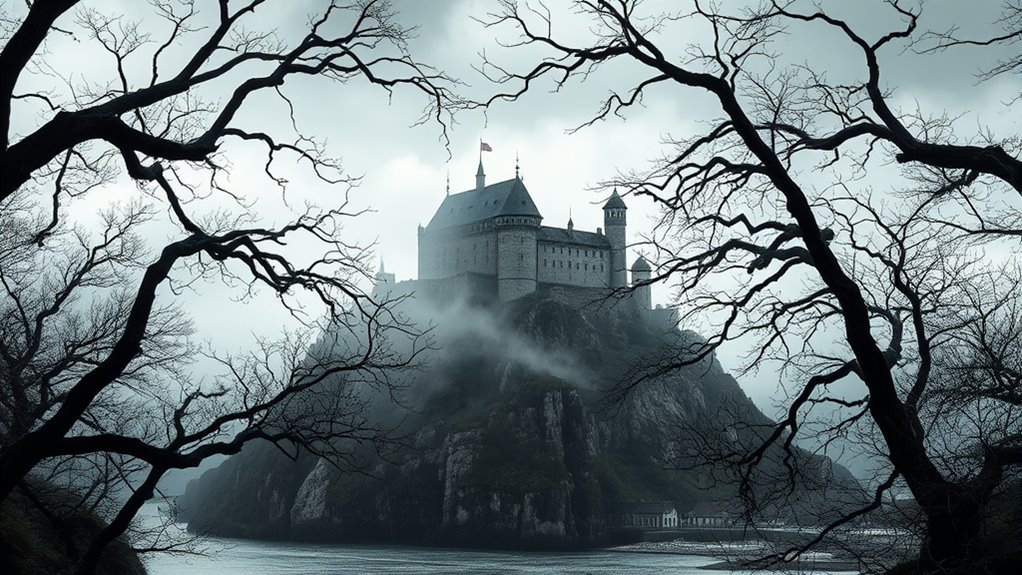
Although often remembered for his brutal methods, Vlad the Impaler‘s reign over Wallachia from 1456 to 1462 reveals a complex leader who balanced terror with effective governance.
His infamous punishing tactics, including impalement, instilled fear among enemies and helped maintain order. During this time, he faced numerous military conflicts against the Ottoman Empire, employing clever strategies to repel attacks, even when outnumbered.
Surprisingly, his harsh rule led to a significant drop in crime, allowing trade and business to flourish.
While German propaganda painted him as a ruthless tyrant, many Romanians see Vlad as a national hero for defending Wallachian autonomy and resisting Ottoman encroachment.
This multifaceted reputation reflects the complexities of leadership in tumultuous times.
Exploring Romanian Folklore and Vampire Myths

Vlad the Impaler’s legacy as a fierce ruler intertwines with the rich tapestry of Romanian folklore, where tales of supernatural beings abound. Among these, the strigoi—undead creatures that rise from the grave—have greatly influenced the vampire myths you know today.
The term “vampirism” gained traction in 17th and 18th-century Europe, coinciding with eerie reports of such beings. The character Dracula, a blend of myth and reality, draws on Vlad III’s history and local folklore about bloodsucking spirits.
Curiously, the Romanian word for “devil,” “drac,” links back to “Dracul,” underscoring the cultural perceptions of Vlad as somewhat demonic. Traditions like using garlic to ward off evil reflect the deep-seated beliefs in protecting against these supernatural threats.
Dracula’s Legacy in Modern Culture and Media
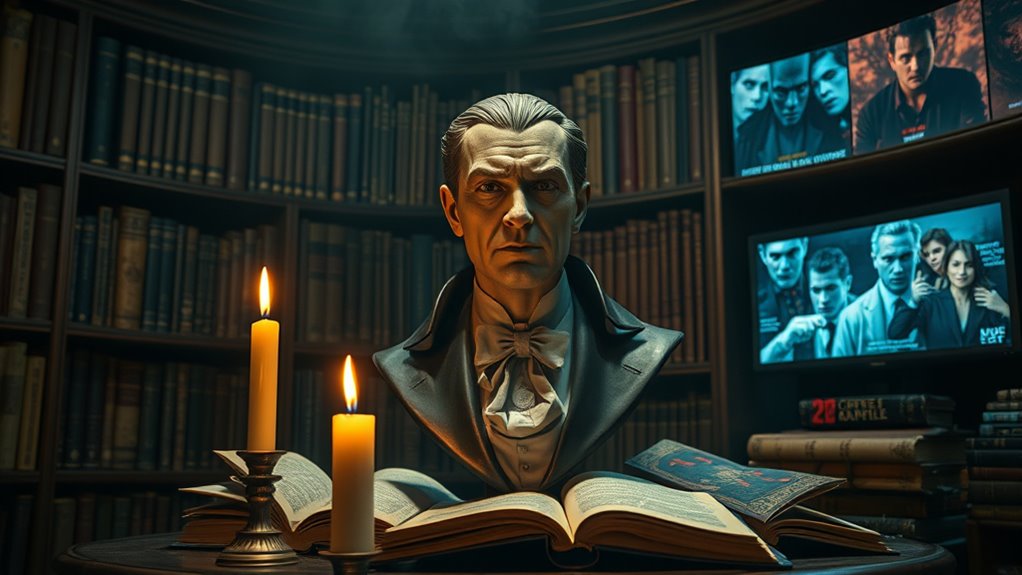
As you explore modern culture and media, it’s clear that Count Dracula, introduced by Bram Stoker in 1897, has become a pivotal figure in vampire lore.
His legacy extends beyond the pages of his novel, influencing a wide array of adaptations, including:
- Iconic portrayals by Bela Lugosi, Christopher Lee, and Gary Oldman
- Family-friendly interpretations in films like Hotel Transylvania
- Darker narratives in series such as Penny Dreadful
- The ongoing fascination with vampire themes of immortality and seduction
Dracula’s Castle continues to captivate imaginations, linking the character to his historical counterpart, Vlad the Impaler.
Dracula’s Castle intrigues, weaving together supernatural legend and the chilling history of Vlad the Impaler.
This connection enriches the narrative tapestry surrounding Bram Stoker’s creation, ensuring Dracula remains a staple in contemporary horror and popular culture.
The Allure of Transylvania: A Journey Through History and Myth
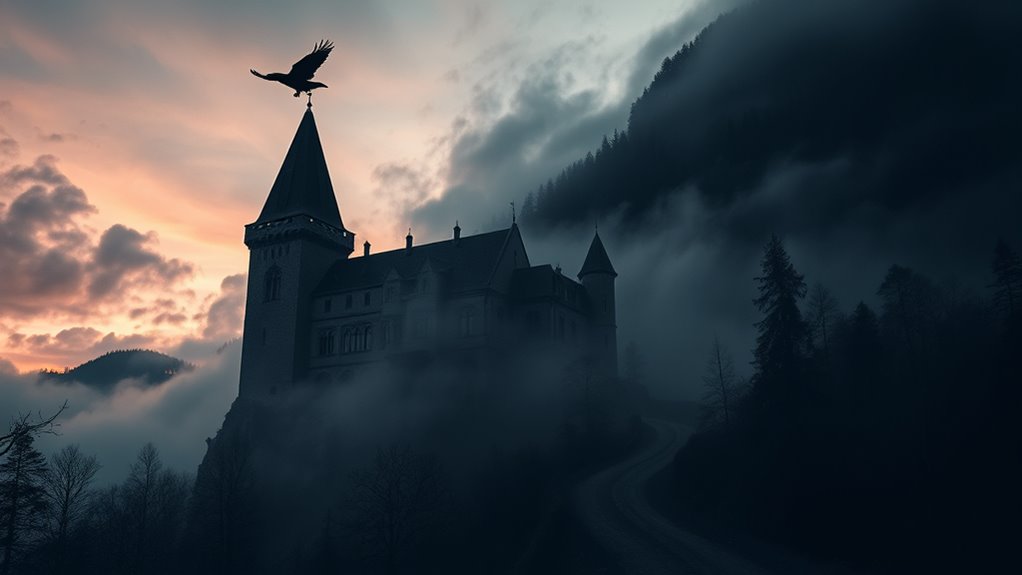
Transylvania captivates with its blend of stunning landscapes and rich folklore, drawing you into a world where history and myth intertwine. Nestled among the Carpathian Mountains, this enchanting region is steeped in the legacy of Vlad the Impaler, the real Dracula. As you explore, don’t miss Bran Castle, often dubbed Dracula’s Castle, which dates back to the 1300s.
Here’s a glimpse of what Transylvania offers:
| Attraction | Description |
|---|---|
| Bran Castle | Architectural marvel linked to Dracula |
| Carpathian Mountains | Breathtaking views and hiking trails |
| Peles Castle | Neo-Renaissance masterpiece |
| Folklore Tours | Immersive experiences of local legends |
Engaging with these sites enriches your understanding of Romania’s complex history and vibrant culture.
Frequently Asked Questions
Is There a True Story Behind Dracula?
Yes, there’s a true story behind Dracula. The character draws inspiration from Vlad III, also known as Vlad the Impaler, who ruled in the 15th century.
While his methods were brutal, he’s seen as a national hero in Romania for defending against Ottoman invasions.
Bram Stoker’s novel transformed him into a fictional vampire, overshadowing the complexities of the historical figure.
Is Dracula a Myth Legend or Folktale?
You’re in for a treat when exploring Dracula’s origins! He’s a mix of myth, legend, and folklore.
While Bram Stoker crafted an enchanting story, the character draws inspiration from historical figures like Vlad the Impaler and centuries of Romanian vampire tales.
This blend creates a legendary figure that’s both feared and revered.
What Is the Tale of Dracula?
The tale of Dracula blends history and myth, centered around the infamous Vlad III, also known as Vlad the Impaler.
You’ll find his reign marked by brutal tactics against enemies, which later inspired Bram Stoker’s 1897 novel.
In the story, Count Dracula emerges as a charming yet sinister vampire, enthralling readers with his dark allure.
This fascinating narrative intertwines with Romanian folklore, creating a rich tapestry that continues to intrigue and attract visitors to Romania today.
Is There Any Evidence of Dracula?
Did you know that over 20,000 people were reportedly impaled during Vlad III’s reign?
When you ask if there’s evidence of Dracula, it’s important to note that historical records, while sparse, do exist.
Letters and accounts from the 15th century highlight Vlad’s brutal tactics and leadership.
These documents provide a glimpse into his life, influencing the legendary figure of Dracula, although Bram Stoker’s portrayal diverges considerably from the historical reality.
Conclusion
In unraveling the legend of Dracula, you discover a fascinating blend of history and myth that continues to captivate us. For instance, a recent documentary explored how Vlad III’s brutal tactics inspired not just Stoker’s vampire but countless horror stories. As you investigate deeper into this chilling tale, you can’t help but wonder: how much of our fascination with darkness stems from the shadows of our own history? The allure of Dracula endures, inviting you to explore further.


